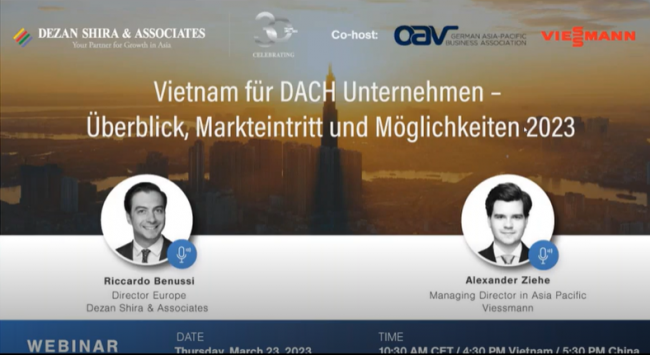Profit repatriation
Remitting profits from Vietnam can prove to be a complex and time-consuming process, even for the most seasoned investors. Shifting regulations and scarce local information on procedures has created a difficult compliance landscape that mandates continued attention from businesspeople.
Although implementing remittance strategies can seem a daunting task, businesses that seek out up-to-date information and plan accordingly are more ready to ensure that profits from their business in Vietnam are distributed abroad in a seamless manner.
Authorities in charge of remittance
For those with current operations within the country, or investors considering setting up in the country, understanding what regulatory bodies and legislation affects business processes is a critical component of business planning.
For those seeking to understand current compliance procedures with regard to remittances, the following governmental bodies and general restrictions on investment should be noted with regard to remittances.
Ministry of Finance (MOF)
The MOF has the power to adjust taxation and regulate remittances within Vietnam. Current areas under the remit of the MOF include powers to:
- Adjust various rates of taxation including but not limited to Corporate Income Taxation, Value Added Taxation, and Special Consumption Taxation; and
- Regulate the conditions that must be met for profits to be repatriated from Vietnam.
State Bank of Vietnam (SBV)
The SBV has the responsibility of regulating banking and foreign exchange within Vietnam. Under the remit of the State Bank of Vietnam are the powers to:
- License banks to operate foreign exchange accounts;
- Set requirements related to the set-up of bank accounts; and
- Issue official rates of exchange between the Vietnamese Dong (VND) and other currencies throughout the world.
Restrictions on remittance
While Vietnam is fairly open to companies remitting profits to their respective markets, investors should note the number of restrictions that are currently enforced upon the remittance process.
If these limitations are not worked into existing business models, they can create significant liquidity problems for those expecting to compensate shareholders or service loans.
Timeframe
Under Vietnamese law, profits may only be remitted once per year. The timing of this remittance is limited by audit requirements that create a yearly window starting from March when profits are allowed to be remitted.
Financial position
Under current Vietnamese law, dividends may not be carried out during a year in which a company has not turned a profit.
Foreign contractor withholding tax
Enterprises subject to foreign contractor taxation
Foreign contractor tax, or generally referred to as withholding tax, is imposed on foreign contractors or foreign sub-contractors. These are defined as foreign organizations or individuals carrying out business in Vietnam under a contract signed with a Vietnamese contracting party or signed with a main foreign contractor (not under a direct investment form in accordance with the investment law of Vietnam).
Parties that conduct business under a contract and make monetary payments to a Vietnamese organization or individual are subject to paying withholding taxes according to foreign contractor withholding tax regulations.
Also, foreign entities that earn income in Vietnam under a contract with a Vietnamese company for the local provisioning of goods through domestic export, or in some cases for distribution or provisioning of goods in Vietnam under an agreement where the seller was had exported the goods into Vietnam, and the goods are not intended for re-export out of Vietnam.
Two types FCWT (Withholding Tax) may apply in various cases:
- VAT (Value added tax); and
- CIT (Corporate Income Tax).
Note: The Foreign Contractor Withholding Tax (FCWT) is detailed in Circular No. 103/2014/TT-BTC.
Calculation
According to Circular No. 103/2014/TT-BTC, the calculation of CIT and VAT for foreign contractors are different depending on the methods of payment. There are three methods available, which are as follows:
Deduction and declaration method
VAT and CIT payments will be filed in the same manner and tax rates as local companies; foreign contractors will be allowed to follow the ordinary method if they satisfy the following conditions:
- They have a permanent establishment or resident status in Vietnam;
- Their duration of conducting business in Vietnam under a contractor or sub-contractor contract is 183 days or more from the effective date of the contract; and,
- They fully apply the Vietnamese accounting system to their business, complete the tax registration and are issued a TIN by a tax authority.
Hybrid method:
- VAT is calculated based on the deduction method, while CIT is determined under the direct method rates on the gross turnover. In order to adopt the hybrid method, foreign contractors and subcontractors must meet the following conditions:
- They have a permanent establishment or resident status in Vietnam;
- Their duration of conducting business in Vietnam under a contractor or sub-contractor contract is 183 days or more from the effective date of the contract; and,
- They maintain the accounting system according to Vietnamese accounting regulations and guidance of the Ministry of Finance.
Direct method:
- This method is applicable when the foreign contractors do not meet one of the conditions mentioned above; the base for calculating VAT and CIT is the taxable revenue. VAT on goods or services used to execute main contracts and subcontracts must not be deducted.
How to Calculate FCWT Rates
Calculation of VAT – Value-Added Tax:
The added value of services or services accompanying VAT-liable goods is the turnover for VAT calculation multiplied by the percentage (%) of the added value to turnover.
Payable VAT amount = Revenue subject to VAT x VAT rate
The added value of services or services accompanying VAT-liable goods is the turnover for VAT calculation multiplied by the percentage (%) of the added value to turnover (see chart below).
Calculation of CIT – Corporate income tax
The CIT amount payable is the turnover for CIT calculation multiplied by the CIT rate (%) based on turnover for CIT calculation.
Custom duties
Most goods exported or imported across the borders of Vietnam, or which pass between the domestic market and a non-tariff zone are subject to export or import duties.
Calculation
The payable import tax or export tax amount shall be equal to the unit volume of each actually imported or exported goods item inscribed in the customs declarations multiplied by the tax calculation price and the tax rate of each item stated in the tariff at the time of tax calculation. At present, export tariffs are codified under Circular 182/2015/TT-BTC.
Rates
Most goods and services being exported are exempt from tax. Export duties (ranging from zero percent to 40 percent and computed on free-on board (FOB) price) are only charged on a few items, mainly natural resources such as minerals, forest products, and scrap metal.
Duty rates for imported goods shall include preferential rates, special preferential rates, and standard rates depending on the origin of the goods.
Payment
Import and export duties declaration are required upon registration of customs declarations with the customs offices.
Export duties must be paid within 30 days of registration of customs declarations. For imported goods, import duties must be paid before receipt of consumer goods, specifically:
- Within 275 days for imported supplies and raw materials intended for the production of exported goods;
- Within 15 days for goods temporarily imported and intended for re-export, as from the deadline for temporary import for re-export or temporary export for re-import, as provided for by competent state agencies;
- Goods imported for export production;
- Goods temporarily imported or exported for the repair or replacement;
- Goods used in the production of digital content, IT, or software; and
- Fertilizers and pesticides that are unavailable in the Vietnamese market.
Transfer pricing
Many foreign businesses delocalize their production facilities in Vietnam and charge their foreign outposts for administrative, technical, financial, and commercial services.
However, financial administration teams need to be aware that their transactions must comply with the arm’s length and substance-over-form principles.
Companies that are considering an investment into Vietnam, as well as those companies that are already operating in the country, need to comply with the regulatory requirements set out in Decree 132 - based on Organization for Economic Cooperation and Development (OECD) and Base Erosion and Profit Shifting (BEPS) guidelines and actions.
Key compliance in Vietnam
Transfer pricing rules are almost the same everywhere as they are generally based on the same principles and share common approaches.
Transfer pricing principals in Vietnam use the substance-over-form principle: foreign investors should review this when structuring supply chains.
Substance-over-form is a principle by which tax authorities look past the legal forms of transactions and operating structures, and instead consider and analyze their economic substance.
What does the substance over form principal mean in practice?
Foreign parent companies that delocalize their production facilities in Vietnam may seek to act solely as a subcontractor, operating through their Vietnamese subsidiary alone. The foreign parent company then seeks to charge its subsidiary on a monthly basis for commercial services performed in regard to developing sales in Vietnam.
According to the substance-over-form principle, those commercial services should contribute to the creation of operating sales revenue or income for the Vietnamese subsidiary. As a consequence, expenses related to commercial services are not deductible from the subsidiary’s taxable income.
Alternatively, if the same Vietnamese subsidiary were engaged in sales activities, then those same commercial service expenses would comply with the substance-over-form principle.
Accordingly, the expenses could then be deducted if the prices charged were at arm’s length (or market rate).
Some companies, however, may seek to engage in more complicated relationships. A multinational enterprise may like to interpose a Vietnamese entity in transactions between two member companies that are residents of countries, which have not signed a double taxation agreement.
According to the substance-over-form principle, associated transactions should have a significant purpose (aside from reduction of tax liability) and an economic effect (aside from any tax effect) in order to be accepted by authorities. In this case, no related expenses would be deductible from the Vietnamese entity’s taxable income.
Finally, from a tax planning perspective, it is worth noting that the previous Decree 20 introduced limitations on the deductibility of loan interest costs, which now – after Decree 132 – should not exceed 20 percent of earnings before interest, taxes, depreciation, and amortization (EBITDA).
This measure is aimed at addressing thin capitalization, as Vietnam lacks specific thin capitalization rules.
How to comply with transfer pricing regulations?
Taxpayers in Vietnam that have entered into related-party transactions have a number of obligations under Decree 132. These have been summarized and set out below:
Forms
Companies in Vietnam that engage in related party transactions need to disclose their relationships and transactions in their annual tax returns.
Taxpayers subject to transfer pricing regulations need to file Form 01 to disclose what transfer pricing transactions they have entered into, and the value of these contracts. Further, taxpayers need to provide what the arm’s-length prices of the related-party transactions would be to enable a comparison.
The timeframe to do this is 90 days after the end of the financial year. This may prove very challenging given the short amount of time to collect and collate all necessary information and data – careful planning and observance are therefore prudent.
Contemporaneous documentation
Transfer pricing contemporaneous documentation is designed to document taxpayers’ relationships and transactions with related parties, as well as their global transfer pricing policies and the allocation of profits among all members/entities within a corporate group.
Taxpayers meeting specific thresholds must, in accordance with Decree 132, prepare, and then maintain transfer pricing contemporaneous documentation, which encompasses a Local File, and one or more of the Master File and Country-by-Country Report (CbCR).
It is likely that the Master File and CbCR will be prepared by headquarters, as they are likely to have direct access to all necessary information. All those documents must be declared by filing Form 02, and Form 03 (for Local file and Master file respectively), and Form 04 (CbCR).
Safe harbors from contemporaneous documentation
Enterprises are exempt from preparing the transfer pricing documentation if any of the following conditions are satisfied:
- Total revenue < VND 50 billion (USD 2.5 million) and total revenue of related-party transactions < VND 30 billion (USD 1.5 million);
- Entered into an Advanced Pricing Agreement (APA) and submitted annual APA report(s);
- Exercise only simple functions, sales < VND 200 billion (USD 10 million) and EBIT, depending on the business, of at least 5 percent (distribution), 10 percent (manufacturing) or 15 percent (toll manufacturing).
Risk/Penalties
If the tax authorities believe the transaction was not priced according to the arms’ length principle, they will adjust the value of the transaction and impose tax accordingly. Furthermore, according to the substance-over-form principle, costs arising from services rendered for the sole purpose of providing other affiliates with benefits or values will not qualify for a deduction from taxable income.
Companies can also be held criminally liable if found to be evading tax. The tax authorities also publish the details of companies that are non-compliant, or report irregularities, on their national and provincial websites – a critical reputational risk.
Managing risk
It is important that companies take the necessary steps to ensure that they are compliant and effectively managing their risk. There are a variety of measures that companies can take. These include:
- Providing disclosures: All companies should disclose information about their related-party relationships and transactions in the prescribed forms and in accordance with the requisite timeframes.
- Risk assessments: Conducting risk assessments to monitor and revise intercompany transactions and planning ahead to create a robust transfer pricing strategy is also an important risk mitigation tool.
- Contemporaneous documentation preparation: Taxpayers meeting the abovementioned thresholds are required to prepare contemporaneous documentation. Companies not meeting the thresholds should however still accurately document their associated party transactions and be able to substantiate the rationale adopted in case they receive any queries or audit notices from the tax bureau.
- Advanced Pricing Arrangements: Taxpayers have the option to proactively manage their transfer pricing risk profiles by entering into an Advanced Pricing Agreement (APA) with the local tax authority. An APA is a binding agreement as to how taxpayers’ transfer pricing arrangement will be taxed.
FAQ: How BEPS 2.0 is Reshaping the Global Tax Landscape for Multinational Enterprises in Asia
Can you tell us about the recent tax developments in Vietnam?
Most recently, Vietnam has brought out new regulations on the enforcement of tax administration and new rules on transfer pricing.
The tax administration regulations as outlined in Decree 126 mainly affect online traders and those in digital commerce such as Netflix, movie streaming websites, and gaming platforms. Previously the government only imposed withholding tax on Vietnamese companies who were involved with overseas companies.
Now overseas companies have to register to get a tax identification number and pay taxes on Vietnam-sourced revenue. The tax authorities have also imposed enforcement measures to enforce tax administration on e-commerce activities. Banks are obligated to report on payments made to overseas entities, particularly to foreign contractors and companies. While we are not sure of the consequences if companies do not comply, the government might take severe measures like blocking the IP address of the website that flouts the rules. The government is also likely to carry out tax audits and tax inspections of e-commerce entities that do not comply.
The second major development is new rules on transfer pricing regulations. The main purpose of the new regulations is to tighten the arm’s length range from the 35th percentile to the 75th percentile and also retrospectively apply back to the 2020 financial year. In addition, the net interest deductions (net of interest expenses less interest income) are capped at 30 percent. The OECD advises between 10 percent and 30 percent rules apply to all local and FDI companies. In fact, FDI companies are subject to stricter scrutiny than local companies due to the tax authority’s limited ability to exchange information with other tax jurisdictions.
What’s the impact of BEPS 2.0 on common structures?
To address the base erosion and profit shifting (BEPS) risks arising from the digitalization of the global economy, the Organization for Economic Cooperation and Development (OECD) issued a statement on July 1, 2021, on reworking the framework for international tax reform.
Commonly referred to as BEPS 2.0, the new framework aims to ensure a fairer distribution of taxing rights is established with respect to the profits of large MNEs and to set a global minimum tax rate.
The BEPS 2.0 package consists of two parts, which is also called the two pillars:
- Pillar One is focused on profit allocation and nexus; and
Pillar Two is focused on a global minimum tax.
There are three types of common structures that may be no longer be tax-efficient due to BEPS rules in Vietnam.
The first is a Phoenix company which is used to exploit certain tax benefits. A Phoenix company is set up to avail tax incentives for a certain amount of time. It is then closed down and set up again with the same business structure to obtain time-based taxed incentives such as four years of tax exemption. However, BEPS would make this redundant.
The second is tax havens. Tax havens are jurisdictions that have very low rates of taxation for investors such as Panama. However, with BEPS you would still need to pay taxes in the country where business is carried out. Pillar one of BEPS 2.0 necessitates that MNE groups pay taxes where they have users regardless of commercial presence.
The third is tax incentive regimes. With BEPS, if a business enjoys tax incentives in Vietnam, they would still be subject to taxes where the parent country is headquartered.
Can you give us an overview of tax incentives in Vietnam?
Vietnam has several tax incentives that appeal to investors. Location-based incentives apply to qualifying economic and high-tech zones, certain industrial zones, and areas with difficult socio-economic conditions. Industry-based incentives are applied to several industries such as education, software, high-technology, renewable energy, and others.
Vietnam also has preferential tax rates such as a flat lifetime tax rate of 10 percent for socialized projects in certain areas with difficult socio-economic conditions as well as a flat lifetime tax rate of 15 percent for agribusinesses. Businesses can also obtain tax holidays for up to two or four years of tax exemption and 50 percent reduction for the next four or nine years.























